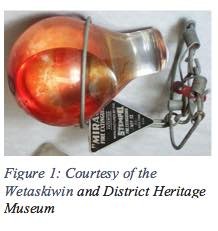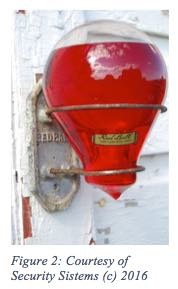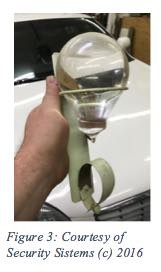
The MAS office will be closed for Christmas Holidays December 24th to January 4th.
Usual office hours will resume on January 5th, 2026
Glass Grenade Style Fire Extinguisher “Bombs:” Are They Safe?
Kathleen Watkin (MAS Advisor)
Emma Morris (Community Engagement Coordinator)
Wendy Fitch (MAS Executive Director)
What are Glass Grenade Style Fire Extinguisher “Bombs?”
Glass Grenade Style Fire Extinguisher “Bombs” are glass bulbs (shaped a little like an incandescent light-bulb) filled with an unknown liquid. These types of fire extinguishers were made and used between the years of 1870 and 1910. They would be stored on metal brackets on the wall. If there was a fire, any person young or old would be able to take it out of the holder, and throw it at the fire. The fire would either be put out by it, or it would help to manage the fire enough for the person to escape the flames.

The earliest glass fire-suppression devices or “fire grenades” were hand-blown, patterned, often colored, round glass bottles, usually filled with salt water until about 1900. After the 19th century, the fancy blown glass began to disappear and a more industrial design prevailed, with smooth, frosted or clear glass. The liquid in the clear glass often had a blue or red coloring agent. In most of the more recent devices, a fire suppression chemical usually carbon tetrachloride (CTC) was used.
In addition to being able to be thrown at the fire, the more recent fire grenades usually had a bracket assembly that suspended them directly over areas of particular fire risk, like boilers and furnaces. If high temperatures reach some styles of brackets, it would release the grenade that would then crash and shatter, releasing the fire suppression liquid. Others had heat-activated, spring-loaded triggers that would break the bottom seal, spilling the liquid onto a deflector that would distribute it over a larger area.

Why are they dangerous?
When the Industrial designed fire extinguishers were made they were unaware of the health hazards that are caused by exposure CTC. Exposure for more than fifteen minutes can lead to respiratory, gastrointestinal, kidney, thyroid, brain, reproductive and developmental problems; which lead to death in many cases. When CTC is exposed to the heat of a fire, it can produce phosgene gas, a chemical weapon used in WWI.
When experts began to understand the long-term and negative health effects of this chemical, as well as how CTC and other chemicals like it – such as Chlorofluorocarbons (CFCs) – were beginning to harm the atmosphere, the chemical began to be phased out of production. The production of CTC has dwindled since the effects were discovered, most noticeably since the 1980s.

How should the Museum “Treat” Glass Grenade Style Fire Extinguisher “Bombs?”
First, Read the Label! If you are luckily enough to have a Grenade Style Fire Extinguisher that has salt water in it, you can carefully display the artifact using supports or a display case to prevent damage.
If the label states it’s contains a fire suppressant or the label is illegible or missing, there are three options you can take to ensure the safety of the artifact and the people who interact with it.
Destroy the Artifact
The Museum Association of Saskatchewan HIGHLY ADVISES the you can have the artifact destroyed. After deaccessioning the artifact from the collection, contact your local Police and Fire Department to see if they are able to safety handle destroying the artifact. If they are unable to help you, Envirotec Services Incorporated based out of Saskatoon and Regina has helped other museums in Saskatchewan for a cost.
Estimate for disposal by Envirotec Services Incorporated
Pricing includes the travel to site and collection of Carbon Tetrachloride bulbs. These are Estimates only including hourly cost not the actuals which would include the truck and technician time and will depend upon distance from Regina or Saskatoon to the museum and the return trip back to the Envirotec facility to process the chemical.

*Actual cost may vary depending on amount of chemical.
Other Options
Custom Mount
If the museum decides to mount the fire extinguisher on a wall using its original brackets with support or creating new brackets, then ensure the space chosen is high enough to prevent easy access and the space is large enough so a secondary mount can be created and placed around the extinguisher. A Plexiglas box should be created and mounted around the fire extinguisher, as well.
If the museum is planning to place the fire grenade inside a display-case or into storage, The Western Development Museum Conservation department advises that a custom made mount be created. In a custom mount the fire extinguisher would be nestled in a custom made cushion which prevents it from moving around and accidently braking. This mount should be made from carved museum quality ethafoam, that is then covered Tyvek to cushion the mount against any rough edges created carving the ethafoam. The glass Fire Extinguisher should be tied using Tyvek ties or archivally safe string into its mount if it is on display. If in storage, a lid should also be included. The Western Development Museum advices that the Workplace Hazardous Materials Information System (WHMIS) and fragile labels be clearly affixed on the mount.
Drain the Bulb
Draining the bulb of its contents is also an option. A conservator using a fume hood in laboratory conditions, creates a small hole by piercing the bottom of the bulb and that whatever fluid is in it is allowed to drip out safely. This process MUST be completed by a trained professional and conducted in a laboratory in a fume hood to ensure the safety of everyone involved. Elisabeth Trudell of the Wetaskiwin & District Heritage Museum, explains the steps involved in this process here: http://wetaskiwinmuseum.com/?p=1101
For More Information, See:
“GFL Environmental.” GFL Environmental. 2019. Website: http://gflenv.com/gfl-locations/saskatoon/
P.O. Box 25055, Saskatoon, Saskatchewan S7K 8B7
100 Cory Road, East Cory Industrial Park, RM of Corman Park, Saskatchewan
Tel. (306) 244-9500
or
P.O. Box 27063, Regina, Saskatchewan S4R 0J0
2B Industrial Drive, Great Plains Industrial Park, Emerald Park, Saskatchewan
Tel. (306) 721-9500
Kibbel III, William. “Common Fire Safety Devices in Old Home a Health Hazard.” Old House Web: Ideas & Advice for Old House Enthusiast.” 2016. Website: http://www.oldhouseweb.com/how-to-advice/common-fire-safety-device-in-old-homes-a-health-hazard.shtml
Ma, Kevin. “Artifacts Under Cover.” St. Alberta Gazette. Sunday, December 8, 2012. Website: http://www.stalbertgazette.com/article/20121208/SAG0801/312089987/
Trudell, Elisabeth. “Extinguishing Danger: Putting out the Potential Hazards of Carbon Tetrachloride.” Wetaskiwin & District Heritage Museum. July 31, 2015. Website: http://wetaskiwinmuseum.com/?p=1101
Sources:
“Carbon Tetrachloride.” Agency for Toxic Substance & Disease Registry. March 3, 2011. Website: http://www.atsdr.cdc.gov/substances/toxsubstance.asp?toxid=35

Usual office hours will resume on January 5th, 2026

Just a reminder that the Final Report for the Museum Improvement Micro Grant for Community Museums is due December 5th! Your final report will require you to provide a brief

Thursday October 16, 202512:00pm CSTOnline via Zoom: https://us02web.zoom.us/j/86760471705?pwd=XjoSlWAP0TJZVYrprylmLqujOkVrk2.1 No registration required. The Museum Grant Program (MGP) provides operational funding to help foster strong, vibrant, community-based Saskatchewan museums that are valued